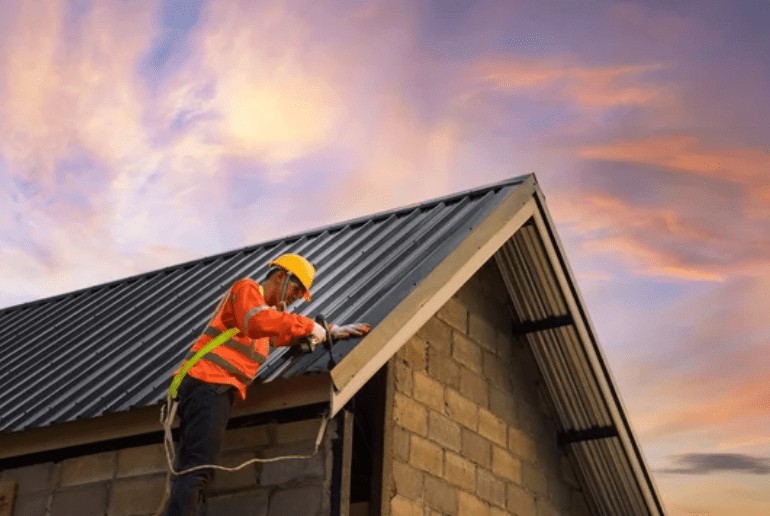
Undertaking a roof installation project is a substantial endeavor that demands meticulous planning and thoughtful deliberation. Whether you’re in the process of replacing an existing roof or installing one for a new construction, there exist numerous pivotal considerations that warrant your attention.
1. Material Selection
Selecting the appropriate roofing material holds the utmost importance when it comes to ensuring the durability and effectiveness of your roof. Many options exist, including asphalt shingles, metal roofing, clay tiles, wood shakes, and others. Each material boasts unique advantages and disadvantages, spanning cost, longevity, visual appeal, and upkeep demands.
To make an informed choice, conducting thorough research and seeking guidance from roofing professionals is wise. Doing so lets you identify the material that aligns most harmoniously with your climate, architectural design, and financial considerations.
2. Roofing Design and Style
The architectural design and style of your roof wield substantial influence over the overall appearance of your property. Elements like slope, pitch, and configuration contribute to aesthetic allure and functional effectiveness. These factors collectively shape the visual appeal while determining how well the roof performs its intended purpose.
Certain designs may be better suited for specific weather conditions, while others might complement the architectural theme of your home. Collaborate with an architect or designer to select a roofing style that aligns with your vision and practical needs.
3. Budget and Cost
Roof installation costs encompass more than just the price of materials. Labor, permits, potential structural modifications, and unforeseen issues can all contribute to the overall budget. It’s crucial to establish a clear budget early on and factor in a contingency fund for unexpected expenses. Obtain detailed quotes from roofing contractors and ensure you understand the cost breakdown.
4. Contractor Selection
Choosing a reputable and experienced roofing contractor is vital to the success of your project. Research local contractors, read reviews, and ask for references. A skilled contractor will execute the installation with precision and guide you through the material selection, design, and permitting processes. Ensure the contractor is licensed, insured, and offers warranties on materials and workmanship.
5. Permits and Regulations
Roof installation endeavors frequently mandate permits from local governing bodies to guarantee adherence to building codes and regulations. Neglecting to secure these essential permits can lead to substantial delays and legal entanglements that incur significant costs.
It is imperative that your selected contractor possesses a comprehensive understanding of local statutes and takes on the responsibility of procuring the requisite permits. This proactive approach safeguards against potential complications and maintains a smooth project progression.
6. Weather and Timing
Weather conditions can significantly impact the progress and quality of a roof installation. Extreme temperatures, rain, or strong winds can hinder the process and compromise the integrity of the building. Plan the project during a season that offers stable and favorable weather conditions for roofing work in your region.
7. Disposal of Old Roofing Materials
In the event of replacing an existing roof, careful thought must be given to managing old materials. Dismantling and disposing of prior roofing materials can be physically demanding and might necessitate specialized disposal techniques. Discuss this aspect with your chosen contractor to ensure a proper and environmentally responsible disposal process.
8. Energy Efficiency and Insulation
A well-insulated and energy-efficient roof can positively impact your home’s comfort and utility bills. Consider investing in quality insulation materials and explore cool roofing options that reflect sunlight and reduce heat absorption. Proper ventilation is also essential to prevent moisture buildup and increase the roof’s longevity.
9. Maintenance Requirements
Different roofing materials have varying maintenance needs. Some fabrics require regular inspections and maintenance to ensure longevity, while others are more low-maintenance. Understand the maintenance requirements of your chosen roofing material and factor them into your long-term plans.
10. Long-Term Durability and Warranty
Lastly, assess the durability and warranty options for your chosen roofing material. A roof constitutes a lasting investment, underscoring the significance of opting for materials capable of enduring the trials of time and nature’s elements.
Moreover, verifying that the chosen materials and the installation process are encompassed by warranties that provide substantial protection and a sense of reassurance is imperative.
Final Word
In conclusion, starting a roof installation project involves a series of critical decisions that can influence the outcome of your endeavor. By carefully considering factors such as material selection, design, budget, contractor choice, permits, and weather conditions, you can set the foundation for a successful and enduring roofing project.
Remember that collaboration with experts, thorough research, and proper planning is critical to achieving a roof that enhances your property’s aesthetics and provides reliable protection for years.

























